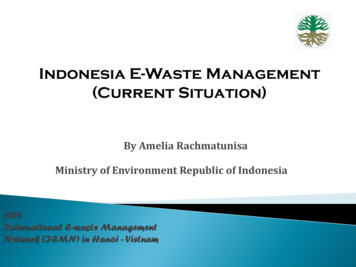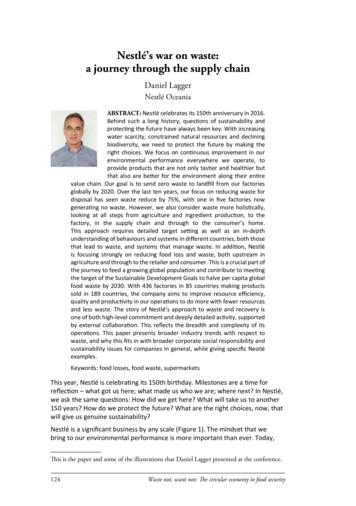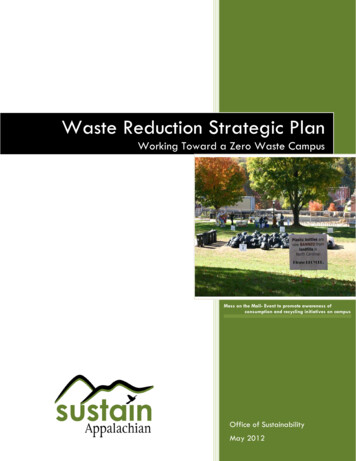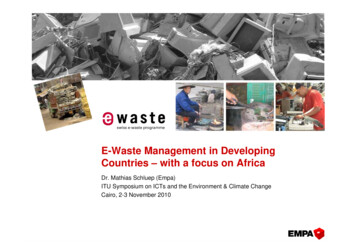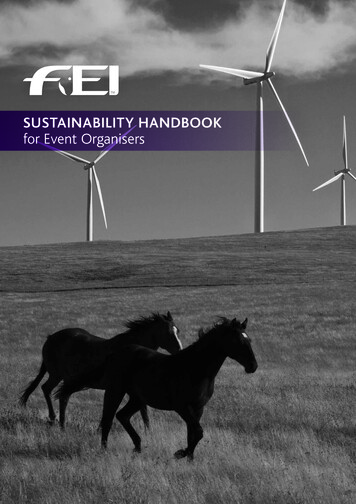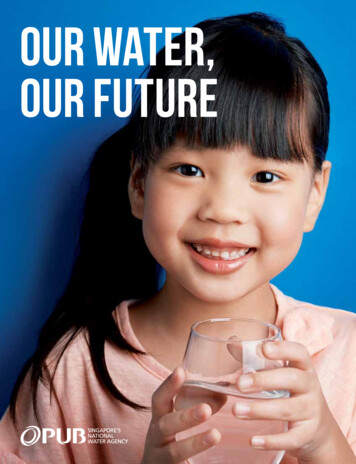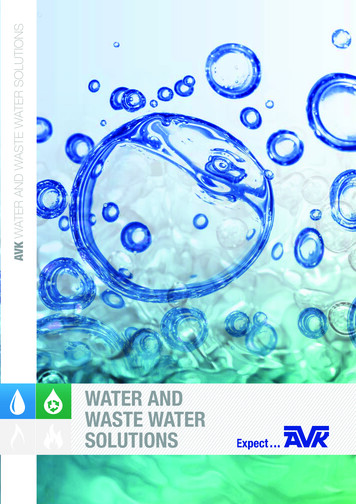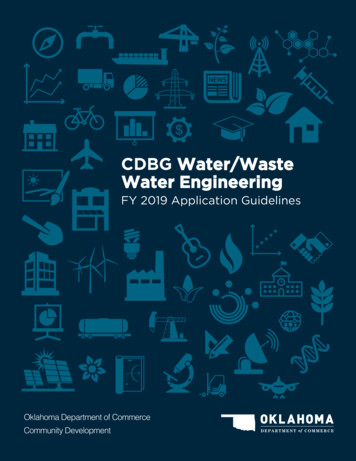
Transcription
CDBG Water/WasteWater EngineeringFY 2019 Application GuidelinesOklahoma Department of CommerceCommunity Development1
State of OklahomaTable of ContentsSECTION ONE: APPLICATION GUIDANCE . 3National Objective-CDBG Funds . 4Eligible Entities . 5Application Submission Requirements . 5Proper Sponsors . 5CDBG Water/Wastewater Engineering Projects – Use of Funds . 5Project Definition . 6CDBG Project Eligibility Policy . 6SAM.Gov Debarred / Exclusion Check Requirement . 7Risk Assessment . 11Proposal Guidance . 12SECTION TWO: REQUIRED DOCUMENTATION . 131. Application Summary and Certification (OKGrants – Online Completion Only) . 132. Documentation of Project Qualification under the National Objective (OKGrants – Online CompletionOnly) . 13(a) Qualifying under the National Objective of Benefit to Low and Moderate Income Person. . 13(b)Conducting an Income Survey . 143. Detailed Line Item Budget (OKGrants – Online Completion Only) . 174. Water/Wastewater Rate Structure (OKGrants – Online Completion Only) . 175. Consultant Form (OKGrants – Online Completion Only) . 176. Audit (OKGrants – Online Completion Only) . 177. Applicant Resolution (Attachment A – Upload to OKGrants) . 188. Citizen Participation Requirement (Attachment B – Upload Form to OKGrants) . 189. Certified Engineering Report & Professional Cost Estimates (Attachment C – Upload to OKGrants). 2010. Section 102 Disclosures and Certifications (Attachment D – Upload Form to OKGrants) . 23Table of Contents12019 W/W Engineering
State of Oklahoma11. Water / Wastewater Rate Verification Documentation (Attachment E – Upload Form to OKGrants). 2312. LMI Documentation (Attachment F – Upload to OKGrants) As Applicable. 2313. W-9 Form & Instructions (Attachment G – Upload to OKGrants) . 2314. Severity of Need Documentation (Attachment H – Upload to OKGrants) . 2315. SAM.gov Exclusion / Debarment Verification (Attachment I – Upload to OKGrants) . 24SECTION THREE: THRESHOLD CRITERIA . 25Threshold Criteria for CDBG Water/Wastewater Engineering Set-aside . 25SECTION FOUR: APPLICATION RATING CRITERIA. 28Rating Criteria for CDBG Water/Wastewater Engineering . 28ATTACHMENTS: A - IAPPENDICES:Appendix A:Direct Project Beneficiary Income Survey Field WorksheetAppendix B:LMI Table DefinitionsAppendix C:HUD OK Low and Moderate Income Percentages by County / Town / CityAppendix D:HUD Income LimitsSection One22019 W/W Engineering
State of OklahomaSECTION ONE:APPLICATION GUIDANCEThe purpose of this Application Guide is to provide guidance in preparing a CommunityDevelopment Block Grant (CDBG) Water/Wastewater Engineering application for the OklahomaDepartment of Commerce / Community Development (ODOC/CD). The primary goals of theCDBG Water/Wastewater Engineering Program are to (1) ensure the most proper technicalsolutions to the applicant’s water and wastewater problems within the budget that is available;and (2) improve coordination among other state agencies (both permitting and financing). It isimportant to note that given the design and intent of the State’s CDBG Water/WastewaterEngineering Program, an eligible application must contain an engineering component regardlessof whether CDBG or leveraged funds are paying for this cost.NOTE: STARTING WITH THE FY 2019 CDBG APPLICATIONS, the former CDBGWater/Wastewater Engineering Phase I and CDBG Water/Wastewater Phase II Programshave been merged into one single program. This new program will be known as “CDBGWater/Wastewater Engineering” and will use a single application to allow for bothengineering and construction.Applicants submitting under the CDBG Water/Wastewater Engineering Program may elect toeither have (1) CDBG funds pay for the engineering, construction, administration, permitting, andother costs associated with water/wastewater project; or (2) provide a combination of CDBG fundsand other funds to pay for these costs.Applicants who successfully compete under the CDBG Water/Wastewater EngineeringProgram and receive an award will be subject to the following project timeline. Prospectiveapplicants should note that this timeline will be strictly enforced by ODOC/CD in order toensure the timeliness of CDBG expenditures as required by the U.S. Department ofHousing and Urban Development (HUD). CDBG Water/Wastewater awardees will receive athree (3) year contract structured as follows:A. Year One – The subgrantee will be required to successfully complete projectengineering and achieve Release of Funds within one (1) year. ODOC/CD will carefullymonitor project activity and subsequent progress. Allowable engineering costs will bebased on the U.S. Department of Agriculture Rural Development (USDA-RD) sliding scale.Once the Oklahoma Department of Environmental Quality (ODEQ) permit and OklahomaDepartment of Commerce/Community Development (ODOC/CD) Release of Fundsrequirements are complete (regardless of the source of funds), the subgrantee will be able toproceed with project construction.(1) If the above deliverables are not met, the contract will be subject to de-obligation byODOC/CD.(2) As part of ODOC/CD’s monitoring and evaluation of the project’s engineering progress,the subgrantee must submit all required documentation as outlined in the CDBG ProjectManagement Guide (https://okcommerce.gov/community/cdbg/) or as otherwise directed bythe CDBG Project Manager to ODOC/CD in a timely manner. Failure to submit any or allrequired documentation will result in contract de-obligation.Section One32019 W/W Engineering
State of Oklahoma(3) Should the contract be de-obligated, any expended CDBG funds will be required to bereimbursed by the subgrantee. The contract will remain open until repayment is made duringwhich time the subgrantee will not be eligible to apply for additional CDBG funding.(4) An ODOC/CD review committee will determine de-obligation of the CDBG funding if theproject’s engineering has NOT been satisfactorily completed and Release of Funds has NOTbeen obtained. This review committee will be composed of ODOC/CD staff to include: CDBGPlanners, the Director of Programs (Planning & Monitoring), and the Division Director.(5) If a subgrantee is de-obligated “in good standing” without any CDBG funds expended, orhas made the proper CDBG repayment as deemed necessary, the subgrantee could closethe contract and reapply during the next year’s application cycle.B. Years Two & Three – Project construction will be allowed for a period of two (2) years plusany time left available should the engineering and Release of Funds be accomplished beforethe one (1) year engineering limit is reached.The grant maximum for the CDBG Water/Wastewater Engineering application is 450,000. Themaximum amount of CDBG Water/Wastewater Engineering funds that may be used for ActivityDelivery Cost (e.g. CDBG Administrator) is eight percent (8%) of the total CDBGWater/Wastewater Engineering funds awarded for the total construction and professional/nonconstruction funds provided. All CDBG Water/Wastewater Engineering applications must bereceived no later than May 1, 2019. Applications received after this date will NOT be consideredfor funding.Applicants are required to complete and submit their respective application and applicableattachments online at the following OKGrants web address: https://grants.ok.gov. NO PAPERAPPLICATIONS WILL BE ACCEPTED. Application guidelines containing the specific programrequirements for the CDBG Water/Wastewater Engineering application is available mmunity/cdbg/.WARNING:Prospective applicants should review the application guidance BEFORE attempting tocomplete the online application. Failure to meet application guidelines or properly submitrequired application documentation may result in a FAILED or DENIED application rating.National Objective-CDBG FundsThe primary National Objective of the Community Development Block Grant (CDBG) Program isthe “development of viable urban communities by providing decent housing and a suitable livingenvironment, particularly for persons of low and moderate incomes.” The use of the “benefit tolow and moderate income persons” CDBG National Objective is considered a funding PRIORITYunder the State’s CDBG Program and is treated as such under the State’s individual CDBG setasides. All project proposals submitted for funding through the CDBG Program must documentthe achievement of at least one of the following National Objectives as delineated in 24 CFR§570.483 (Criteria for National Objectives). Potential applicants are REQUIRED to contactODOC/CD before the submission of any CDBG application if intending to use a National ObjectiveOTHER than “Providing benefit to low and moderate income persons”. Provide benefit to low and moderate income persons. Aid in the prevention or elimination of slums or blight.Section One42019 W/W Engineering
State of Oklahoma Meet other community development needs having particular urgency, posing a serious orimmediate threat to the health or welfare of a community.Eligible EntitiesEligible applicants for the CDBG Water/Wastewater Engineering Program are units of localgovernment (incorporated towns, cities, and counties) that are not participants in the CDBGEntitlement Program. Oklahoma’s entitlement cities are Edmond, Enid, Lawton, Midwest City,Moore, Norman, Oklahoma City, Shawnee, and Tulsa as well as the units of local governmentparticipating in the CDBG Urban County Designation for Tulsa County which consists of thefollowing:City of BixbyCity of Broken ArrowCity of CollinsvilleCity of GlenpoolCity of JenksCity of OwassoCity of Sand SpringsCity of SapulpaTown of SkiatookTown of SperryUnincorporated Tulsa CountyApplication Submission Requirements1. City/Town and County (Direct Jurisdiction) Applicants: City/Towns and Counties receivinga direct jurisdictional benefit may submit only one (1) grant application per CDBGProgram Year selecting from CDBG Water/Wastewater Engineering, CDBGWater/Wastewater Construction, CDBG Community Revitalization, or CDBG Rural EconomicAction Plan (REAP). A City/Town and County (Direct Jurisdiction) cannot submit a CDBGapplication if it currently has an open CDBG grant. Exclusions: Economic DevelopmentInfrastructure Financing (EDIF) and Capital Improvement Planning (CIP). Typical Countydirect jurisdiction CDBG application projects are roads, bridges, County hospital, etc.2. County Sponsored Applicants: Counties acting in a “sponsorship” capacity may submit amaximum of one sponsored CDBG grant application per CDBG Program Year selecting fromWater/Wastewater Engineering, Water/Wastewater Construction, Community Revitalization,or Rural Economic Action Plan (REAP). Limitation: Counties may ONLY have one (1) opensponsored CDBG grant and still make another sponsored CDBG application. Countiescannot exceed a maximum number of two open sponsored CDBG grants open at anygiven time. Exclusions: Economic Development Infrastructure Financing (EDIF) and CapitalImprovement Planning (CIP). Counties may sponsor applications where they do not havedirect jurisdiction over certain public functions. Generally, these are communities with lessthan 25,000 in revenue, Rural Water Districts, and Rural Fire Districts.Proper SponsorsThe process of determining which unit of government (a town, city or county) should submit orsponsor an application for CDBG Water/Wastewater Engineering assistance must include anexamination of the relationship between the location of proposed improvements in the servicedelivery area, and the proposed beneficiaries. The unit of government with direct jurisdiction overthe majority (60%) of the proposed beneficiaries must be the sponsor or applicant for CDBGWater/Wastewater Engineering funds. However, in the event that no unit of local government has60% of the proposed beneficiaries, then the unit of local government with the majority of proposedbeneficiaries must sponsor the application for grant assistance. Also, in some instances a countymay submit an application on behalf of a town or city that cannot meet the financial requirementsidentified in the Threshold Requirements in this guide.CDBG Water/Wastewater Engineering Projects – Use of FundsSection One52019 W/W Engineering
State of OklahomaAll projects shall be single purpose, either water or wastewater that will focus on some of the mostserious problems in the state. Eligible applicants submitting under the Engineering competitiveprogram may elect to either have (1) CDBG funds pay for the engineering, administration andother costs associated with securing a construction permit with the Oklahoma Department ofEnvironmental Quality (ODEQ); (2) may choose other sources of funds to pay for these costs; or(3) provide a combination of CDBG Water/Wastewater Engineering funds and other funds to payfor these costs.ODOC/CD has identified the need for comprehensive energy audits. An energy audit is aninspection, survey and analysis of energy flows for energy conservation in a building, process orsystem to reduce the amount of energy input into the system without negatively affecting theoutput(s). A comprehensive energy audit helps to identify and prioritize ways a town, city, or ruralwater district can save both energy and money. This comprehensive and in-depth study shouldreview potential energy-saving opportunities by considering all feasible options and combinationsin both new and existing systems. A W/S Engineering application may include the cost forconducting a comprehensive energy audit as part of the requested CDBG Water/WastewaterEngineering project funding not to exceed 1% of the total CDBG funds requested for construction.Project DefinitionUnder the State’s CDBG Water/Wastewater Engineering program, a project is defined as ONEeligible or sponsored unit of local government (UGLG) applying for ONE activity in which there isa benefit to only ONE geographically TARGETED AREA or an entire COMMUNITY-WIDE AREA.These areas allow for an activity in which only ONE LMI survey (as applicable) is required. If theproject doesn’t meet the above definition it will be disqualified resulting in a FAILED applicationrating.CDBG Project Eligibility PolicyProspective CDBG Program applicants are strongly encouraged to review (24 CFR 570 SubpartsA, C, I, K, and O) of the Electronic Code of Federal Regulations (https://ecfr.io/Title-24/) foradditional regulatory CDBG Program guidance as related to State CDBG Programs. The Housingand Community Development Act Section 105(a) and 24 CFR 570.482 defines eligible activitiesunder the State CDBG Program. While some regulatory language is direct, there are instanceswhere more clarity is needed.It is the policy of ODOC/CD that should a prospective CDBG Program applicant request a CDBGproject/activity that does NOT appear directly eligible and cannot be immediately determined asineligible as interpreted from CDBG regulatory guidance and ODOC/CD staff that the applicantcan formally request ODOC/CD to seek a final determination from HUD officials.a. The prospective applicant will be required to submit a project/activity narrative regardingthe requested activity. This will be required by HUD to conduct their review and make adetermination. It is the responsibility of the prospective applicant to provide the narrative.The submission of the narrative to ODOC/CD will be seen by as the formal request to seeka final determination from HUD.b. Once a detailed project narrative is received by ODOC/CD, it will be submitted to theOklahoma City HUD office for a final eligibility determination.Section One62019 W/W Engineering
State of OklahomaProspective applicants are advised to seek project/activity guidance as soon as possible fromODOC/CD if they have eligibility concerns. Prospective applicants should be aware that finalCDBG regulatory and program guidance can take several months to receive from HUD.ODOC/CD understands that prospective applicants are subject to CDBG application deadlines;however, in absence of a final project/activity determination from HUD, ODOC/CD cannot allowan award for any requested CDBG project/activity that cannot be determined to be directly CDBGeligible. If the project/activity eligibility determination hasn’t been received from HUD by the CDBGapplication deadline, the application will receive a FAIL threshold rating. Applicants are advisedto consider that a determination may not be received by the CDBG application submission date.SAM.Gov Debarred / Exclusion Check RequirementThe System for Award Management (SAM) is an official website of the U.S. government. Youmust have an active registration in SAM to do business with the Federal Government. Thereis no cost to use SAM. The General Services Administration (GSA) is required by the FederalAcquisition Regulation (FAR) to compile and maintain a list of parties debarred, suspended, ordisqualified by federal agencies in SAM.gov. Units of General Local Government (UGLG’s),contractors as well as recipients of federal financial assistance must be registered at SAM.gov.Active registration in SAM is required to apply for an award and for HUD to make a payment.ODOC/CD is required by HUD to check UGLG grantees’ debarment/exclusion status in thefederal SAM database and place a record on file. You can use this site for FREE to: Register to do business with the U.S. governmentUpdate or renew your entity registrationCheck status of an entity registrationSearch for entity registration and exclusion recordsPer the SAM User Guide, the No Active Exclusions field on the SAM Entity summary indicateswhether the entity has a current debarment. SAM.gov will check the exclusions list for the DUNSnumber of your entity and indicate whether any exclusion records exist. If an active exclusionrecord exists for your entity, this question will default to “Yes,” meaning that the contractor isdebarred. No Record Found means that the entity is not registered or has let its registration lapse.The entity should ensure that the email address is current in SAM.gov so that when automatedreminders are sent to renew registration each year that this reminder does not go into spam dueto an obsolete email address.How do I start a SAM registration? If you have not yet started your registration, pleasecreate an individual user account and log into SAM to register your entity. To register in SAM,at a minimum, you will need the following information:U.S. REGISTRANTS:1. Your DUNS Number, Legal Business Name, and Physical Address from your Dun& Bradstreet (D&B) record. If you don't already have one, you can request a DUNSNumber for FREE from Dun & Bradstreet (D&B).Section One72019 W/W Engineering
State of Oklahoma2. Your Taxpayer Identification Number (TIN) and Taxpayer Name associated withyour TIN. Review your tax documents from the IRS (such as a 1099 or W-2 form) tofind your Taxpayer Name.3. Your bank's routing number, your bank account number, and your bank accounttype, i.e. checking or savings, to set up Electronic Funds Transfer (EFT).If you already started your registration, check your status by entering your DUNS Number orCAGE Code in the SAM Status Tracker. You will be required to upload the PDF copy providedwhich the check which shows that the UGLG is NOT excluded into OKGrants.SAM.Gov Website Exclusion Check – NOTE: CONDUCT A PUBLIC SEARCH. DO NOTLOG INTO SAM.Gov. This will ensure that the information is available for PUBLIC review.Choose “Search Records” and then use “Quick Search” Enter the UGLG’s nine digit DUN’snumber in the “DUNS Number Search” field. Select the “SEARCH” button the bottom of thepage.Save a copy of the search by selecting the “Save PDF” button at the top of the box. This willprovide the electronic PDF file copy needed to be uploaded into the CDBG application inOKGrants.Section One82019 W/W Engineering
State of OklahomaNEW LOGIN PROCESS FOR SAM.GOV – Update July 2018What is the new login process for SAM.gov?The first time you log in to SAM.gov after June 29, 2018, you’ll be asked to create a login.govuser account (if you don’t already have one). Going forward, you will use your login.govusername and password every time you log in to SAM.gov. Your current SAM.gov usernameand password will no longer work.Login.gov is a service that offers secure and private online access to government programs,such as federal benefits, services, and applications. With a login.gov account, you can signinto multiple government websites (including SAM.gov) with the same username andpassword.If you already have a login.gov account check the email address associated with it. If yourcurrent login.gov account matches the email address associated with your SAM.gov account,you are ready for the new login process. Otherwise, you will need to create a new login.govaccount the first time you log in to SAM.gov after June 29, 2018.Why do I need my current SAM.gov user account email address?If you use any other email address to create your account at login.gov other than the oneassociated with your SAM.gov account, your SAM.gov roles will need to be reassigned. Thiscould cause delays in updating your existing registrations.How do I find the email address for my SAM.gov user account?Section One92019 W/W Engineering
State of Oklahoma If you don’t know which email is associated with your SAM.gov user account, contactthe supporting Federal Service Desk at www.fsd.gov, or by telephone at 866-606-8220(toll free) Monday through Friday from 8 a.m. to 8 p.m. (ET), for FREE assistance.What do I need to create my Login.gov user account?Through SAM.gov, create a login.gov account (if you don't already have one). Your oldSAM.gov username and password won't work anymore. You'll need to: Create a login.gov account if you don’t have one. You only need to do this once. If you have a login.gov account, check the email address. - If you already have alogin.gov account, the associated email address must match the email addressassociated with your SAM.gov account in order to migrate your roles. If the emailaddresses don’t match, you’ll need to create a new login.gov account. If you don’t have a login.gov account, enter an email address. Use the same emailaddress you use for SAM.gov. If you don’t currently have a SAM.gov account (are abrand new user, for example), you may use any email address you have access to. Create a new password. Pick how you want to receive security codes. You need a working phone number(mobile or landline) or an authentication app (installed on your mobile or on yourcomputer). Login.gov will use your phone or your authentication app to send you aone-time security code for authentication.How do I sign into SAM.gov after I create my Login.gov account?Every time you select “Log In” on SAM.gov, you'll go to the login.gov sign-in page. You needto enter your login.gov email address, password, and the one-time security code that youreceive. You can tell login.gov to remember your browser which stores your security code for30 days.Why did SAM.gov make these user account changes? To further increase security and deter fraud, SAM.gov is partnering with login.gov toimplement multi-factor authentication for registered SAM.gov users.Does this change impact public users who do not log in to SAM.gov? No. There is no change for users who search and view public data on SAM.gov withoutlogging in to the system.Can I get help for this new login process? Yes. SAM.gov has additional instructions, the Federal Service Desk will be availableto support, and you can go to login.gov to learn more about creating an account.Section One102019 W/W Engineering
State of OklahomaAlleged Fraudulent Activity in SAMThe GSA has taken action to address alleged fraudulent activity in the System for AwardManagement (SAM). The measures GSA already put in place to help prevent improper activityin SAM include masking specific data elements in the entity registration even for authorizedentity users; requiring “parent” approval of new registrations for their “child” entities; andrequiring the formal appointment of the Entity Administrator by original, signed notarized letter.Additional enhanced controls have been deployed. These controls include implementingmulti-factor authentication using login.gov and notifying Entity Administrators when there is achange in the entity’s bank account information.NOTARIZED LETTER PROCESS CHANGESHow has the notarized letter review process changed?All non-Federal entities who create or update their registration in SAM.gov will no longerneed to have an approved Entity Administrator notarized letter on file before their registrationis activated. Hint: This applies to you if your SAM.gov Purpose of Registration is either FederalAssistance or All Awards. Check SAM.gov to find your Purpose of Registration. All non-Federal entities still must mail the original, signed copy of the notarized letterto the Federal Service Desk.Where can I find the notarized letter templates?Read the instructions for domestic entities posted at the Federal Service Desk.Where do I send the notarized letter?You must mail the original, notarized letter to:FEDERAL SERVICE DESKATTN: SAM.GOV REGISTRATION PROCESSING460 INDUSTRIAL BLVDLONDON, KY 40741-7285Risk AssessmentODOC/CD performs monitoring of the CDBG projects. Not every project will be monitored on site.Desk monitoring may be utilized for projects that are low risk or when the Grantee has anexemplary management history.ODOC/CD has developed a monitoring strategy that targets a sampling of projects or activities.This sampling is based on risk factors associated with various types of projects and/or GrantRecipients. While every project receives some level of monitoring, priority for in-depth evaluationand review is given to projects that are:Section One112019 W/W Engineering
State of Oklahoma1. Multi-jurisdictional, i.e., involving more than one unit of local government;2. Involve some level of risk, as evidenced by:a. Lack of recent history in administering a CDBG project;b. Evidence of numerous accounting or financial tracking errors on current orprevious projects;c. A record of serious findings or sanctions in previous monitoring session;d. High turnover of administrative staff;e. Delays in submitting required reports;f. Prior violations;g. Failure to attend and participate in implementation workshops;h. Excessive tardiness in responding to prior monitoring findings.3. By definition, economic development projects are considered high risk.In addition, CDBG Water/Wastewater Engineering subrecipients must meet certain thresholdrequirements listed in the CDBG Water/Wastewater Engineering application guidance. Thesethreshold requirements assist ODOC/CD to assess risk and to award funds to those potentialsubrecipients with the best administrative and financial capacity to manage grants.Proposal GuidanceTechnical assistance regarding eligible projects, project concepts, the application guidelines, andother information pertaining to the CDBG Water/Wastewater Engineering Program is availableupon request.Applicants are encouraged to contact the staff persons listed below anytime they are uncertainwith regard to program requirements, project conceptualization, or any portion of the applicationpacket and/or guidelines.CDBG Water/Wastewater Engineering Application in
Water/Wastewater Engineering” and will use a single application to allow for both engineering and construction. Applicants submitting under the CDBG Water/Wastewater Engineering Program may elect to either have (1) CDBG funds pay for the engineering
